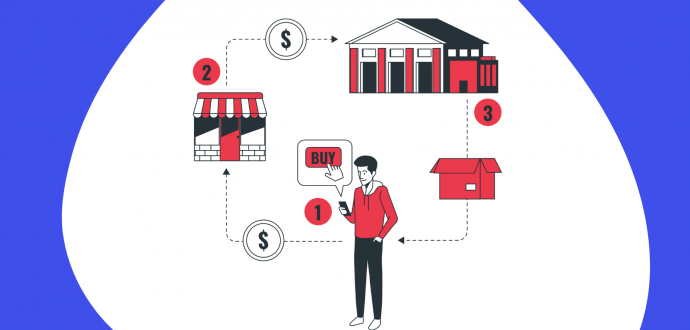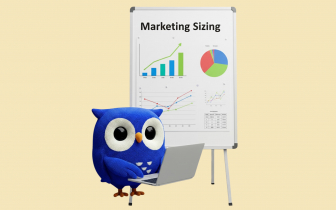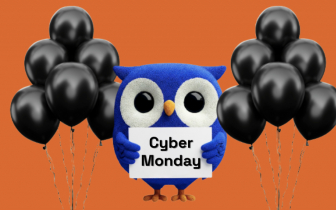Indirect Distribution Channels Explained With Examples

It seems like you are at that exact point of your business journey when you are trying to figure out how to make your distribution the most effective.
If that’s like that, congratulations — you’re in the right place! We’ve already covered all the distribution channel basics in our previous guide.
Yet, we know many of you are still confused when choosing between direct and indirect distribution channels. That’s why we’re going to dig deeper into this topic with a strong focus on the the indirect option.
We’ll also analyze a couple of real-life examples that can help you decide for sure whether this approach works for your business.
What is indirect distribution all about?
When people talk about the indirect channel of distribution, they are referring to when companies use middlemen parties to get their products or services to their end users. These could be distributors, partners, wholesalers, retailers, dealers, or even resellers and agents.
About 75% of all e-commerce transactions are carried out as indirect sales — that’s a huge number. Apparently, that also means that businesses that are not using this method are missing out on 80% of their sales opportunities.
Direct vs. indirect distribution: What is the difference between them?
So, what is the difference between a direct and an indirect channel of distribution? Well, it’s kind of like the difference between night and day, light and darkness. Okay, we’re kidding, but you get the point — they are direct opposites of each other.
In the direct distribution channel, your business works to deliver products directly to your customers without the help of any middleman. This allows you to maintain control over your prices and brand marketing message and get direct feedback from the customers.
With the indirect channel, you get your middlemen who are the link between you and the customers. You get to share logistics costs with them and can easily reach more markets. Sounds awesome, but it also comes with its own issues (more on that later).
If you’re still confused when it comes to direct vs. indirect models, here is a comparison table:
Advantages of indirect model
You may have heard people say that more hands make the work lighter. It’s the same thing here. There are tons of perks that a business owner can expect when going for indirect distribution channels, such as:
Reach more markets
The indirect channel automatically gives you the ability to reach way more potential customers than you could ever manage on your own.
This is possible because each intermediary is a potential bridge to many more people on their own. You will be tapping into their existing client base when you bring them on board.
So, if you have hundreds of them, that’s potentially hundreds of thousands or millions more potential customers. Imagine having one of the giant chains as a partner — your product can end up in tons of locations in an instant.
Share costs
Another advantage of the indirect option is that it lets you share some of the costs. It takes a lot of money to set up your own distribution network — like a whole lot. So, it is a great perk to be able to share that burden with others.
With your intermediaries, you won't have to set up warehouses in every region where you want to supply goods, nor will you be paying for every single delivery fleet, driver, local staff, etc.
Tap into more localized knowledge to drive more sales
Let’s face it — every business wants to expand, and the more you know the area, the better you can connect to the people there. This is what makes the indirect model so great.
Chances are that your distributors, wholesalers, partners, etc., will know their territories like the back of their hands and already have good relationships with people there.
As they know a lot more about their surroundings, working with them will make it easier to reach your goals of expansion and make more sales quicker.
Since indirect channels of distribution allow you to share the burden with others, it also means that you are spreading the risks with them as well.
Disadvantages of indirect model
Alright, now you are thinking — surely it can’t be all rosy. And you are right. So, let’s look at some indirect distribution advantages:
You don’t have as much control
If we were to choose just one disadvantage of indirect distribution channels, this would be the first one to pop up. The issue with having a lot of people involved in a project is that you have to give up lots of control.
When it comes to indirect channels, there is little power over how your product is presented across different regions, which can dilute your overall brand message and affect how your brand is perceived.
Besides, don’t forget that you only have limited direct interaction with your customers, so it could become harder to personalize your brand messages for each customer.
The good thing is that you can always use a guest posting service to raise more awareness about your brand values and messages with people in any part of the world.
Potential conflicts
It might be hard to believe, but not every external sales partner will share your passion for your products and services. This can create conflicts between the sales channels.
For example, territories may overlap, and competition can arise between partners in the product and services portfolio they represent. This can end up affecting your relationship with the different parties involved and create tension as well.
The same thing can also distort the market information you receive and even delay the time it takes for you to receive the updates.
You have to share the profits
Since you are sharing the costs and risks with your partners, it is only fair that you also share your profits as well. As a result, this can affect your overall profit margin, which is especially tough if production costs are high.
Still, the partners can also directly increase your sales, so you have to weigh the pros and cons before you decide if this is the right solution for you.
Having seen both sides of the indirect vs. direct distribution coin, you now know that it’s important to be very selective about the intermediaries you choose to partner with and then figure out ways to keep them properly motivated.
Real-life brand examples
Beyond the indirect distribution definition, it is even more important to show you examples of companies that were able to pull this off successfully.
Adidas
Source: Adidas
Some of the biggest fans of the indirect option are the businesses in the clothing industry, and Adidas falls under this group. Adidas has made a name for itself as a powerhouse brand for sportswear, and part of its success can be traced to its distribution channels.
Adidas has physical stores scattered across major cities around the world, where customers can just walk in and get their products and experience personalized services. The same option is also available on their websites.
But that’s not all. The company also partners with many intermediaries, including wholesalers, to help ensure its products reach more target markets. You can also find their goods on many online e-commerce sites like Amazon, Asos, Farfetch, etc.
Source: Amazon
Besides, since eligible people can easily sign up for the Adidas affiliate program, it has encouraged influencers and smaller retail outlets to team up with the company and earn a nice commission.
Working with wholesalers is a giant part of the strategy Adidas uses. How giant? Well, the brand has twice as many partner-owned distribution centers as they do their own.
Source: Adidas 2022 Annual Report
All in all, Adidas works with official distributors like AFS, retailers, and affiliates to ensure their product reaches the final customer on time and in good condition. All these partnerships also ensure that Adidas is literally everywhere.
Summed up, their distribution channels look like this:
Source: FourWeekMBA
Nestle
Source: Nestlé
Most food and beverage companies use indirect channels to sell their products to the end customers. If you have ever bought baby food, bottled water snacks, or dairy products, then you know Nestle.
It is, after all, one of the most diversified and well-known food companies in the world, with factories all over the world.
Nestle, like most food and beverage companies, uses an indirect model where they rely heavily on wholesalers to get their products to as many places as possible. Keep in mind that the company has over 2000 brands and 340 factories in 76 countries.
Source: Nestlé
Nestle currently has suppliers in more than 188 countries around the world. And this strategy helps them guarantee quick delivery of their products to the target markets.
Since it’s quite easy for businesses to sign up to become distributors with Nestle, it’s logical that the company has a very extensive market reach. Besides, they partner with third-party logistics providers, which makes them one of the best global supply chains.
Four things to consider when choosing this distribution model
At this point, you may have solved the indirect vs. direct distribution dilemma for yourself. Are you leaning more toward the former? If that’s the case, here are some things to keep in mind when making that call.
1. Costs
Each distribution channel requires some costs to set up. In the case of indirect channel, even though you’re sharing some expenses with others, do the math.
Apart from the obvious payments (like logistics), you may have to run ads in new regions or buy backlinks to make your products/services more recognizable.
2. Goals
What are your goals? More independence? More control? If so, indirect channels aren’t your solution.
You should choose indirect distribution only if it helps you achieve your goals, like getting your products faster to the end user and expanding your market reach.
Yet, apart from your own objectives, make sure you align with your partner’s business goals as well. You have to be a match. Otherwise, it will cause you a headache further down the road.
3. Partners’ reputation
One of the downsides of the indirect model is that it’s unlikely that you will find partners who are all as passionate about your business as you are. But overall, that’s okay. Just make sure they aren’t biased or have a conflict of interest.
Still, make sure your potential partners have:
- The financial stability to fulfill their own part of their deal,
- Extensive market coverage,
- The right experience,
- Good relationships with the target audience.
To ensure this, you might want to ask around to see what the word-of-mouth about them is.
4. Performance
Before you even think of going indirect, check your industry's best practices to see how one knows that their partner is doing well. This will help you define some proper performance metrics.
Is it sales numbers, profits, or something else? How often should there be performance evaluations? Are there any incentives to motivate them (e.g., rewards for high performance)? If so, what are they?
The earlier you answer these questions, the better for everyone involved. Of course, it's okay to make adjustments as time goes on but establish some clarity from the start.
Conclusion
As we’ve seen in this article, indirect channel distribution is quite widespread across different niches. After learning about all its benefits, this doesn’t sound surprising.
If you go about it the right way and choose the right partners, you can help your business grow faster than ever.
Still, before choosing this channel, make sure to weigh both sides of the coin and learn as much as you can about potential risks.








